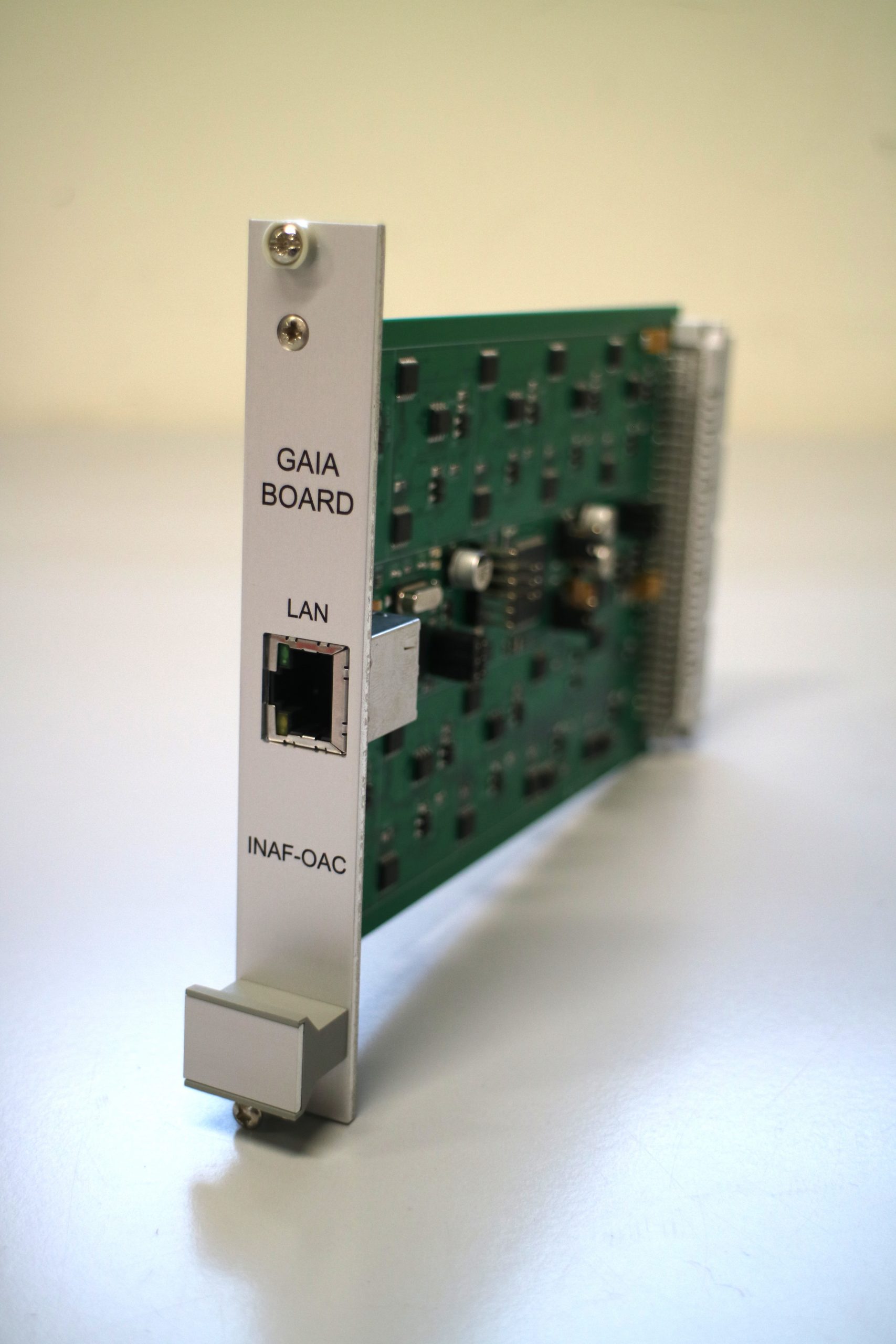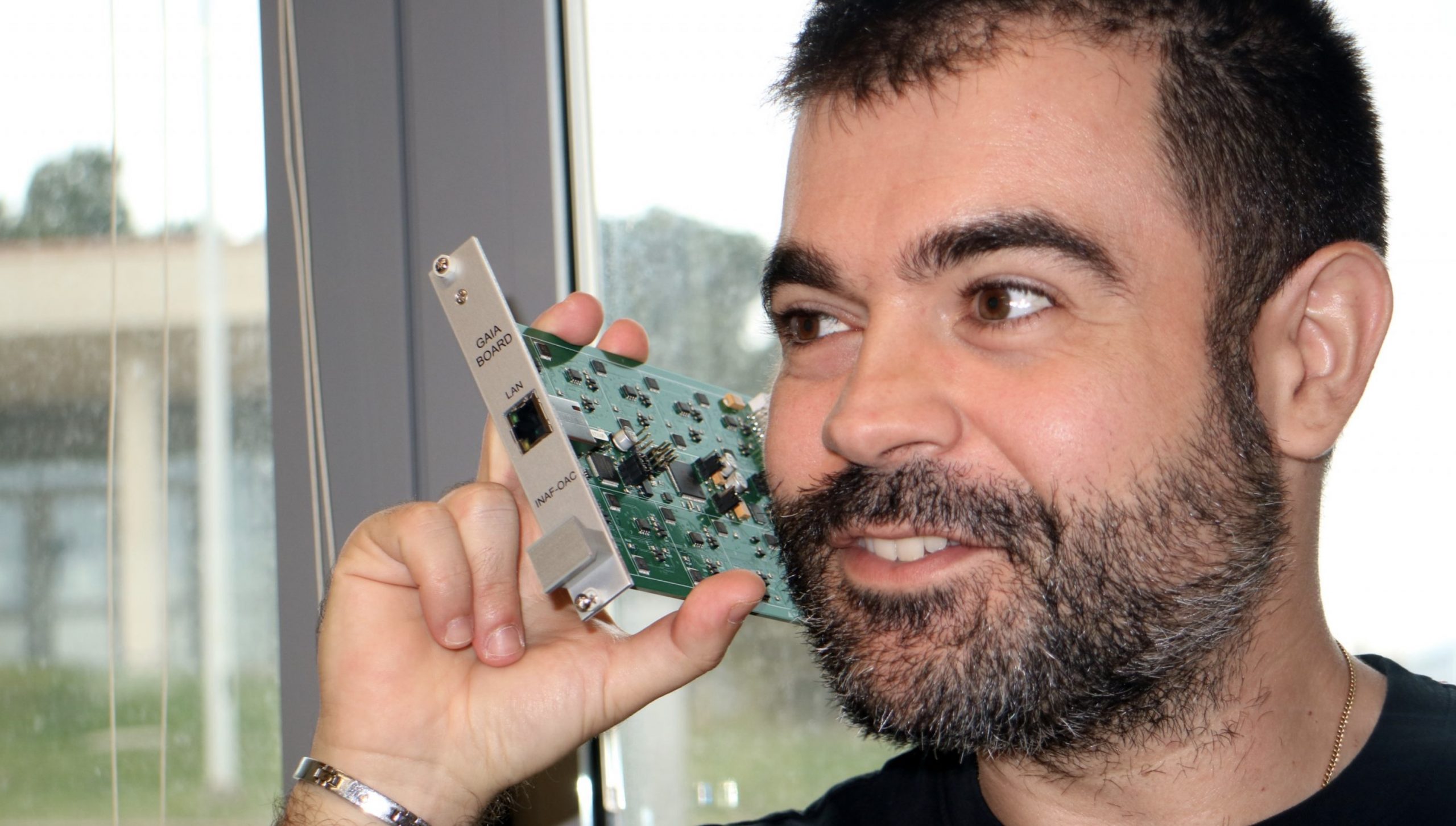Pierluigi Orto, electronic engineer in charge of the Optoelectronics Laboratory of the INAF – Astronomical Observatory of Cagliari and the Gaia project, has placed some Gaia cards in a holder that will be installed in the receiver of the Sardinia Radio Telescope. Credits P. Solita/INAF
Radio telescopes are large dishes that receive and process very weak electromagnetic waves coming from various sources in the universe, such as stars and galaxies. In these complex technological systems, everything revolves around the personality and sensitivity of the “receiver” and the threats to its normal functioning, which are mainly radio interference (in English, Radio frequency interference, or RFI). Radio interference that comes from other broadcast antennas – such as telephones, radios and televisions – but also from wind farms, cable channels, electrical substations, non-working household appliances, alarms, electric gate motors, etc. Not only that, but electromagnetic interference is caused, above all, by the receiving systems of the radio telescopes themselves, because they require electricity to operate. For this reason, new solutions and new ideas are constantly being studied.
One of the most advanced and internationally pioneering technologies has now been found through collaboration between the National Institute of Astrophysics (Inaf), the Italian Space Agency (Asi) and the Department of Electrical and Electronic Engineering (Diee) of the University of Cagliari. It can also be read at study Published in May of this year in the American magazine Access to IEEEa team led by an electronic engineer from INAF in Cagliari Pierluigi Orto In fact, it has developed an electronic card that promises to be a radical game-changer in terms of receiver management, reduction of radio interference, optimization of time and, last but not least, work safety during radio astronomical observations for Radio Sardinia. Telescope (for now).
Between concept, development and control Gaia – This is the name of the card, it is not an acronym and has nothing to do with the ESA mission of the same name – It has been seven years, plus countless hours of work for a working group of nine people from the three institutions involved. Today, in 2023, Gaia has become a reality and is already being implemented on some of the new receivers available for the Sardinia Radio Telescope, which has been built For example Thanks to the recently completed Pon-Innovazione project. But how does this card actually work? Let’s start with the cooled receivers and then move on to their power supply.
Cryogenic receivers
Cryogenic receivers (literally “cold producers”) require a lot of electrical energy to maintain them at their expected working temperatures – constant and very low, very close to absolute zero. This is achieved through progressive systems that can be defined as “cold Matryoshka dolls” that use Helium gas. The cold slows the atoms of the receiving surfaces to almost a stop, ensuring that an external signal is received in an environment that is as quiet and therefore silent as possible.
In addition to just receiving the signal, receivers also have the task of amplifying it as much as possible using special devices called Low noise speakers (LNA), i.e. low noise amplifiers. After crossing this first external receiving interface – the End of introduction – The signal can be digitized and processed in the following environment – Back end – to then be available as data that radio astronomers can use. In practice, the receiver is the interface between the real signal coming from the sky and the amplified, digital signal underneath the system.
Power supplies of receivers and concept prejudice
Similar to the mechanical concept of “torque” – which in an internal combustion engine represents the maximum efficiency between engine rpm and power supplied – there is also ranges Optimal performance, called “prejudice“: that is, the point of balance between different types of current and voltage (voltage GateStress sink And the current of sink) where the electrical flow reaches maximum efficiency and produces minimal unwanted electromagnetic emissions. To make sure prejudice The receiver was always in perfect condition, and technicians and engineers at INAF and ASI developed a monitoring system capable of transmitting remotely – that is, via a cabled LAN – from the receiver to an existing computer. there is chance control roomOutside the telescope – timely information about the state of the receiver and about the quantity and quality of the incoming electrical flux. However, there was no ability to control and intervene.

The Gaia Card promises to revolutionize the management of the Sardinian Radio Telescope receivers, and in the future also other radio telescopes, Italian and foreign, thanks to the possibility of remote control of the current flows ideal for their operation. Credits: B. Solita/ENAF
In fact, as soon as any anomalous data or malfunction was detected, it was always necessary to physically intervene on the receiver mounted on the telescope to regulate this electrical flow, literally armed with a screwdriver to “give a half-turn” and re-establish the correct flow of current. It is not difficult to imagine the practical implications: stopping the telescope and securing it in a standing position, organizing a mission for the technicians inside it (with the relevant communications, scheduling, and bureaucracy), and the risks associated with working at heights. Interventions that therefore required a lot of “antenna time” and inevitably affected the timing of observations already scheduled, causing them to be interfered with, delayed or cancelled.
All this could soon become just a memory, if not for everyone, then at least for a significant part of the receivers currently active on SRT, because the Gaia system provides – in addition to the remote monitoring of the receiver parameters already available – above all possibility of interfering with electrical flows Directly remotely, optimized to the maximum extent, thus avoiding the physical mobilization of technicians and engineers to search for the fault. Of the approximately ten receivers currently designed for SRT, more than half are already ready for assembly and use of this new system, which represents a revolutionary and world-leading novelty from a certain point of view.
Pierluigi Orto Enaf does not hide his enthusiasm for this result. “There have been years of hard work, together with colleagues from Asi and Diee, to improve every detail of this card to the maximum extent it represents so far. Not plus ultra In terms of technology and efficiency in radio astronomy, real Standard Which is already making headlines thanks to its publication in the relevant American magazine. In order to have such a profitable business environment, the Sarda Sensors project, led by Tonino Pisano and funded by the Sardinia Region, has been fundamental to open up our technological development towards the local community and companies. The genesis of Gaia began from this context. I would also like to emphasize the fact that most of the people involved in the project started out in a precarious situation. Although many human resources are unstable, they are essential for the implementation of important projects, and their value should be appreciated and protected by the indigenous institutions with due attention.
to know more:

“Infuriatingly humble social media buff. Twitter advocate. Writer. Internet nerd.”


